At last it began. Months and months of sheer endless waiting drew to an end as I packed my stuff to finally embark on the big great voyage: Seven full consecutive days onboard a sailing yacht! What a prospect. But it wouldn´t be a pleasure cruise at all, no casting off for fun. It would be the so-called “SKS-Praxistörn” as we are saying here in Germany – the practical education for the German RYA Yachtmaster Coastal Skipper-equivalent. A sailing trip with an exam at the end.
It would be neck or nothing.
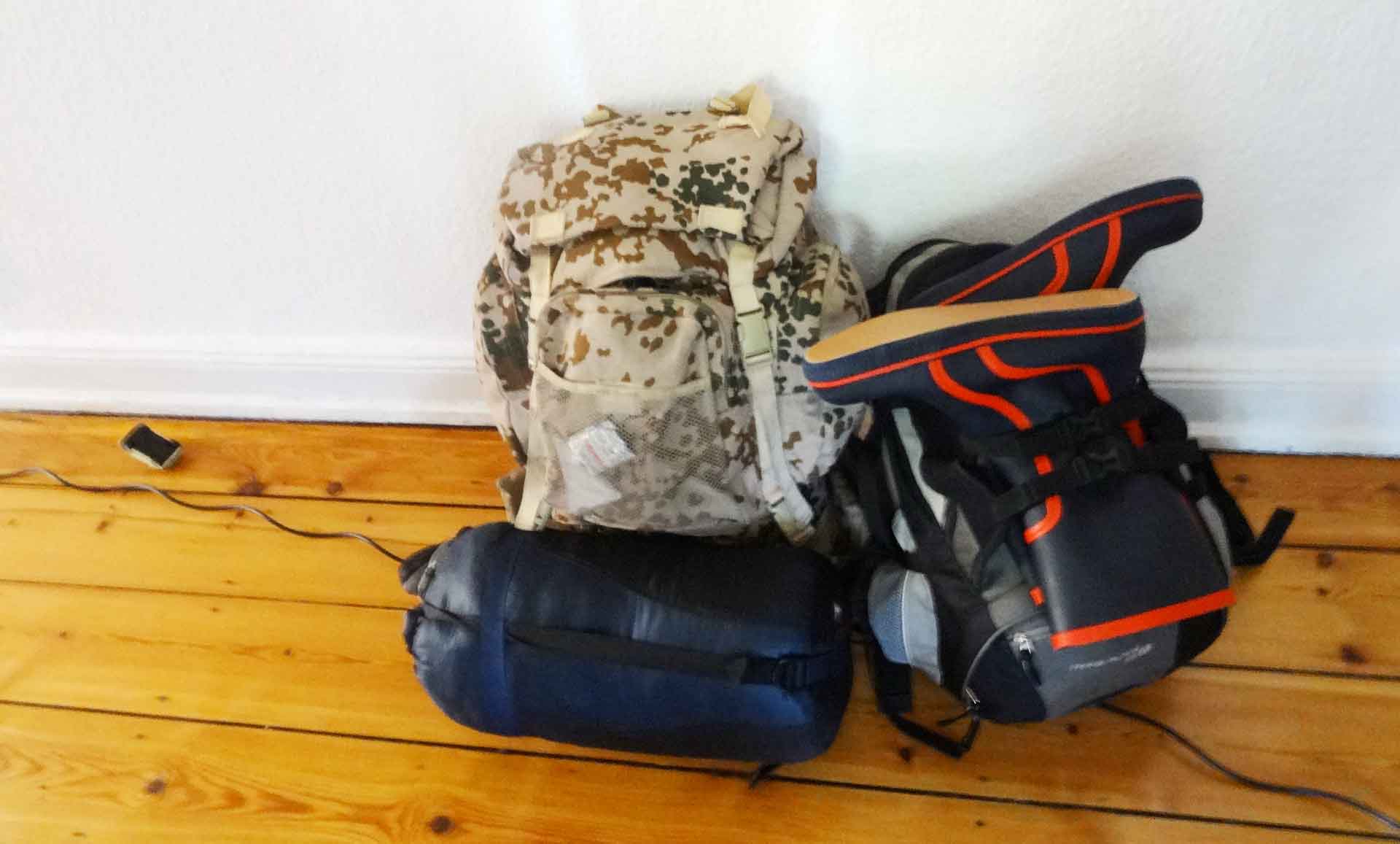
The Yachtmaster Coastal Skipper, or SKS (Sport-Küstenschiffer) as we call it in Germany, is divided into two sections, each concluding with an exam. The first part is the theoretical stuff. It comprises of a total of 500 questions, some 100 for each of the topics navigation, legal stuff, weather and two big chapters on proper seamanship. The other part is a practical exam in which the skipper-in-being has to show his sailing skills. Most people do their SKS by beginning with the theoretical part, I interchanged, starting by the practical sailing following the advise of Richard Jeske, owner of Well-Sailing school, one of the most renowned in Hamburg and Northern Germany. It´s not a desirable prospect sitting down at home having to learn answers to some 500 different questions when there´s 25 Degrees Celsius outside …
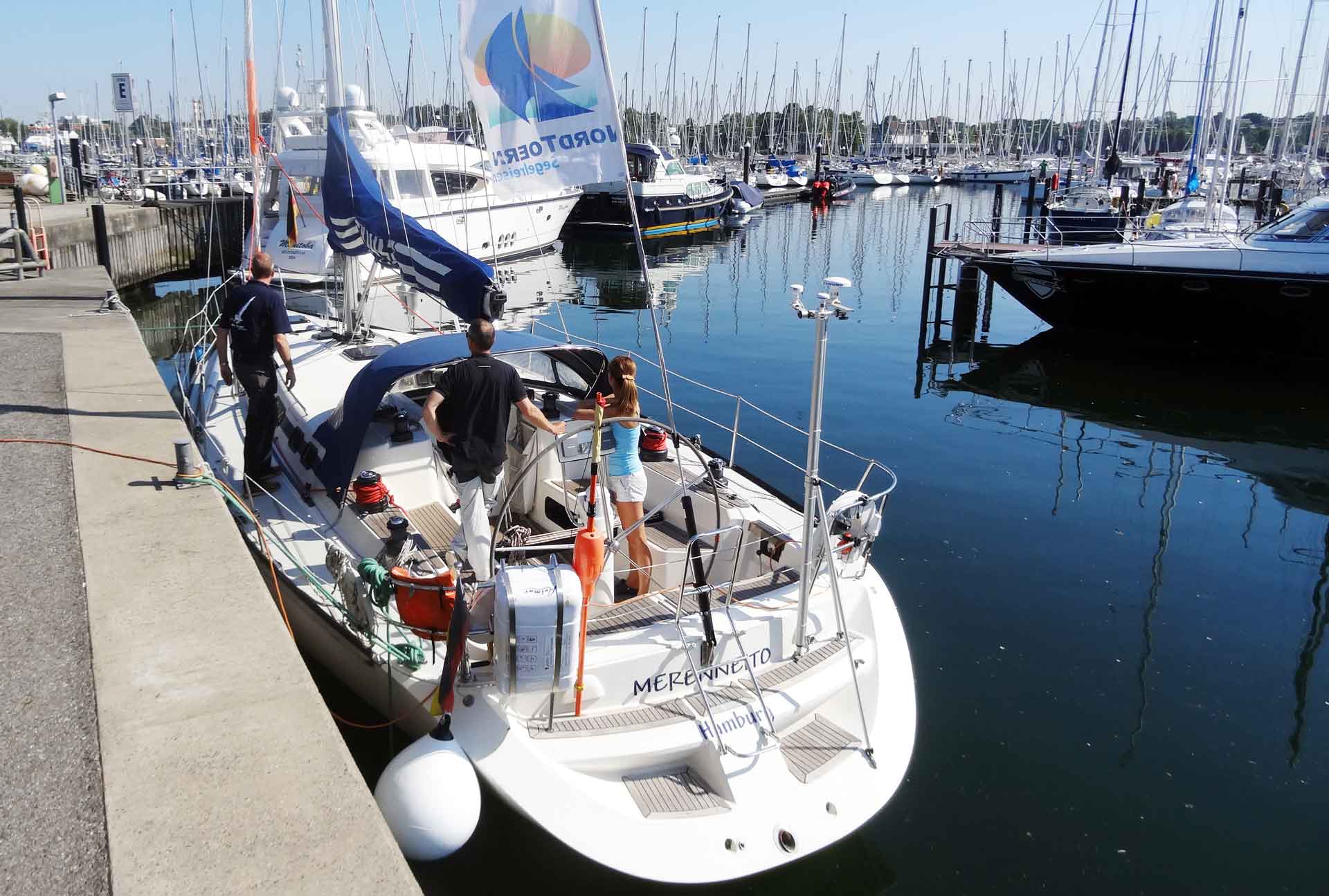
Arriving at Ancora Marina of Neustadt, a small ex-fishing town at the Baltic shores, I met my fellow crew-mates and took a first glimpse at our home for the coming 7 days. Matthias, Volker and Egbert embarked with me, unloaded their luggage and occupied the cabins of SY MERENNEITO, a fine X-442 sailing yacht made by X-Yachts of Denmark. A nice, sleek and – as we would be later learning – a fast ship as well. Perfectly suitable for learning how to sail a big yacht. Matthias and Egbert are – as I am – declared for the examination for the Coastal Skipper, Volker does sail with us to gain experience on boats somewhat bigger than the yawls he was accostumed to. He will have his examination on a consecutive trip.
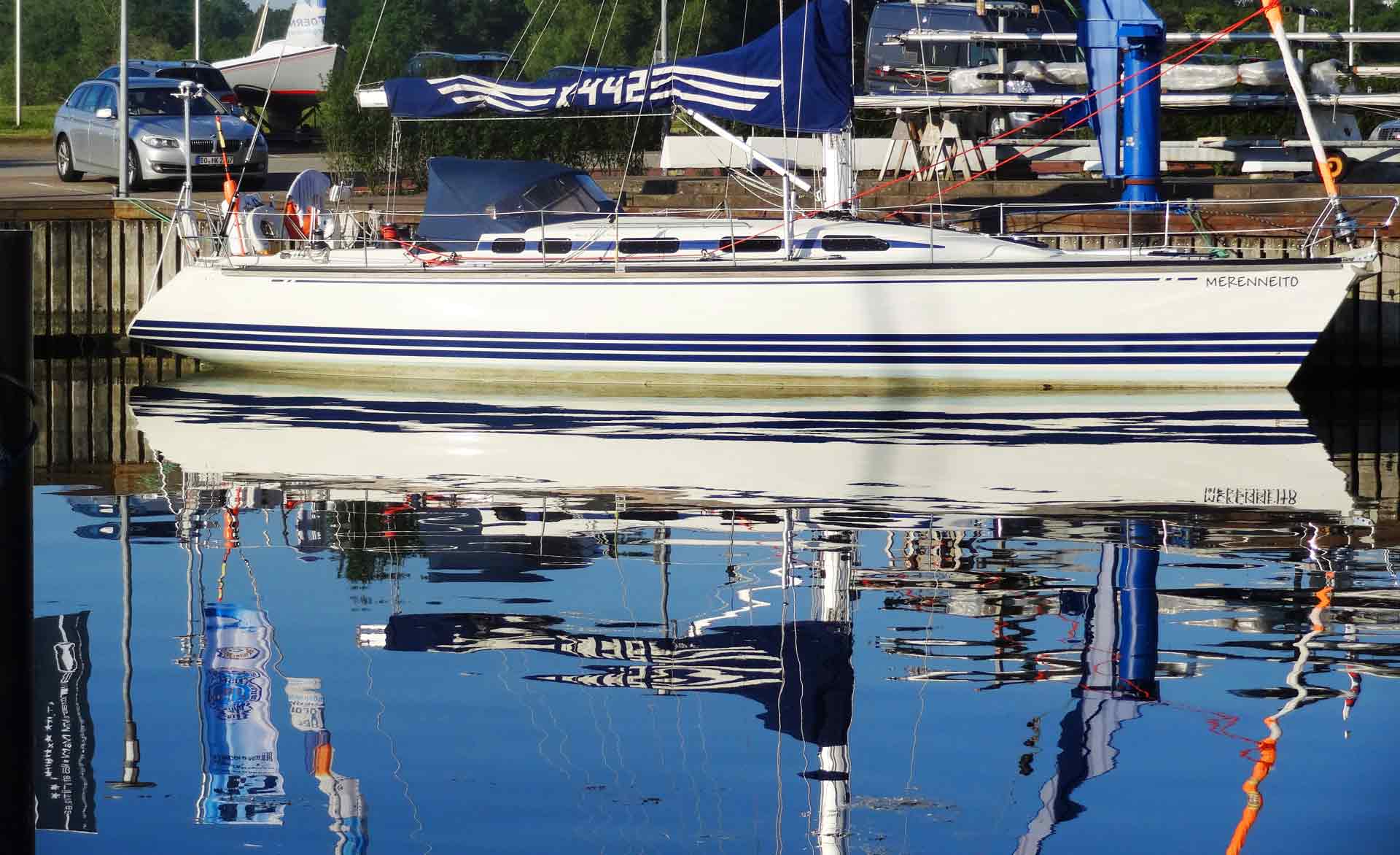
Some minutes later or skipper arrived. Dietmar. Himself an experienced sailor, on the water since he was a little child. His tall figure infused trust and respect, his mood calm, sympathetic and funny from time to time. With him he introduced Andrea to us. She herself being an experienced skipper and doing some kind of internship to get to know our sailing school´s didactic concept for joining the team. So it´s 4 pupils and 2 teachers. Perfect conditions as normally we would be 6 pupils and one single teacher. A happy omen for the whole class?
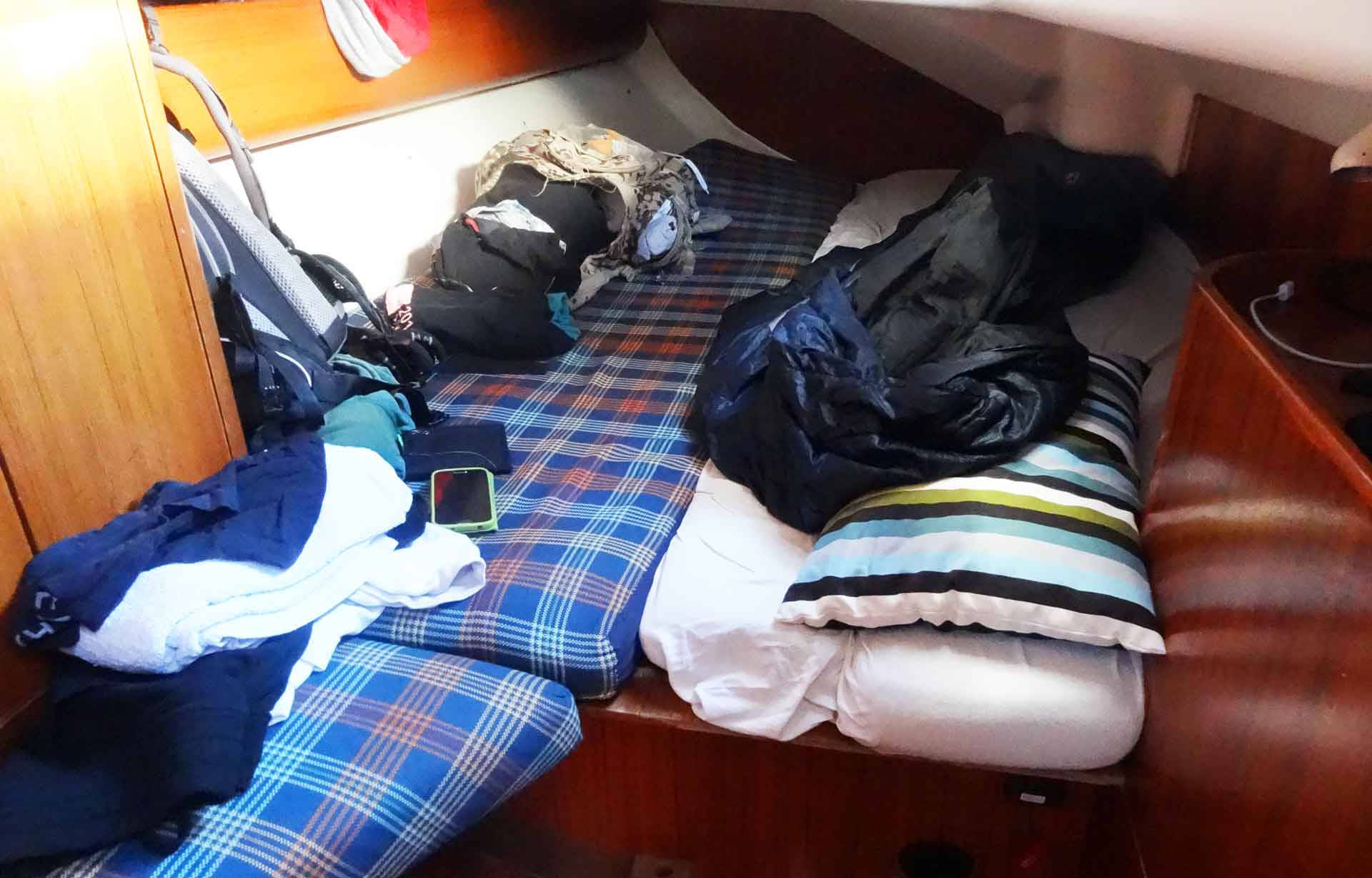
I drew the aft starboard cabin and stowed my stuff into the various cupboards, prepared the bunk and got ready for the first lessons. Just on time, 10 o´clock a.m. Dietmar and Andrea boarded the vessel and the class officially began by the safety briefing. Having had such briefings on various occasions before I thought I´d knew what would come – but was amazed by the style and profundity of Dietmar´s thorough briefing. That´s wwhat it should be like, I thought: It took him nearly 2 full hours to explain the safety procedures and features of our yacht, proper behavior when at sea, distress and MOB equipment and a general introduction to the boat itself. I´ve never experienced a better and more professional briefing than this. First lesson learned, I was also puzzled by the professionality of our skipper. “One hour lunch time, prepare to cast off afterwards”, he said: “Let´s go sailing in the afternoon.”
I couldn´t eat a thing – too much pleasant anticipation.
“You´re a dab hand? You know nothing.”
When lunch time was over, we returned to our X-Yacht 442 and prepared to cast off. Taking down the main sail tarpaulin and cockpit-roof, stowing safely away all stuff below deck, closing all sea-valves and portholes we put on our live vests and stood ready to receive orders. “Who wants to do the first casting-off?”, Dietmar asked. And as nobody raised his arm, it was mine going up. “Okay, take the helm and tell your crew how you are going to pull off your maneuver”, Dietmar encouraged me. Having a look up the mast from where the wind was blowing, I dug deep into the theoretical knowledge and came up with the standard procedure when mooring alongside a quay: Inching in the quarter spring to bear away the stern … Well, Dietmar raised his eyebrows: “That´s the standard procedure as taught by the book … here´s another suggestion …”, he said and explained how he would cast off.
A trick.
Never heard of before. Too much roping going on, a bit puzzled we pulled off his advice, had installed a seaward aft quarter spring on the middle clamp, hard rudder port, cast off! And – like a wonder – the stern beared away from the quay, rudder midship and machine slightly forward our 44 feet yacht had a nice and smooth start. This time it was our eyebrows raised: Never casted off in such a stylish, quiet, safe and yet precise way.
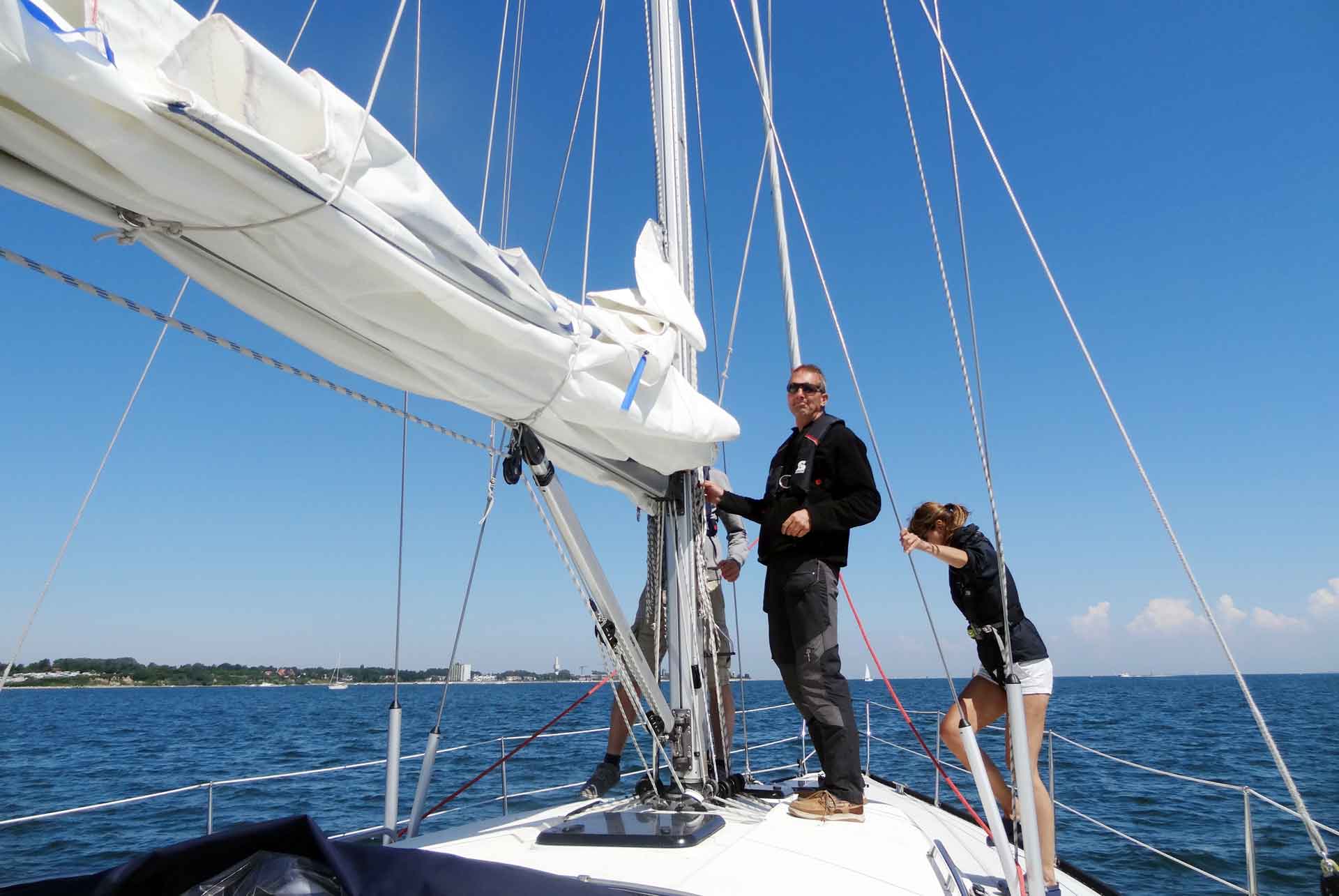
After I steamed MERENNEITO out of Neustadt harbor, followed the fair way to the open sea and Dietmar announced “Ready to hoist sails!”. That´s a no-brainer, I thought, and again, had to explain to “my” crew how I intended to pull off this maneuver. When talking about the steps, I kind of anxiously watched Dietmar´s facial expression: Will he be fine with my instructions or again come up with an alternative? Of course he did: Our X-Yacht was equipped with in-boom reefing roping which I had no idea of how to deal with, I forgot the boom vang and other details (but got it right to put the yacht into the wind … and got at least on thing right …).
And so we did, some 3 minutes later or main was up in the wind, first reef. Hoisting the fore sail was nothing, again, as we are a teaching-boat, our X-442 had a storm jib. “Bear off to broad reach!”, Dietmar advised and so I did – the crew slow and clumsy reacting at the winches.

We changed helmsman. I took my station on the mainsheet winch. Having her go under sails filled my heart with joy, as sailing is in my eyes the most beautiful way of bridging distances. But there wasn´t any time for romantic contemplation as Dietmar went on to test our abilities. “Come up to close hauled!”, “Bear off to close reach” … command after command followed as every one of us had to take the helm for some 20 minutes an bring our yacht through the various points of sail. The first lesson, as I understood later, was a test as well to determine our precognition. Handling the huge 44 feet boat proofed a no-brainer – the X-Yacht is responsive, easy to steer with virtually no pressure on the rudder. Even under storm job and reefed main, having a 3 to 4 bft wind, we made up to 7 knots flat. Exciting. “Ready for tacking!”, Dietmar announced and I instinctively grabbed the main sheet rope: “Ready!”, I declared.
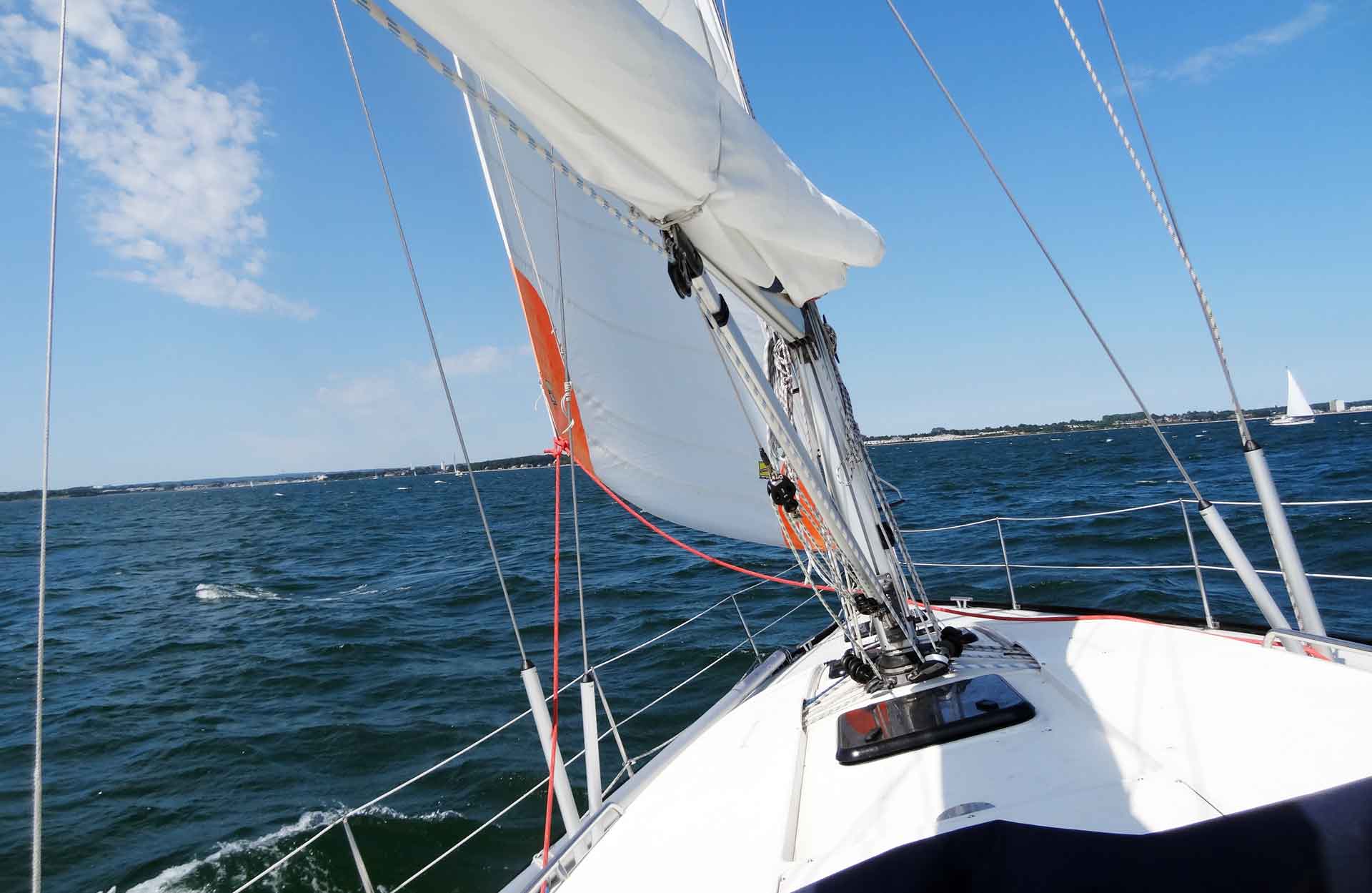
When we all announced being ready, our helmsman yelled “Tacking!” and gave full rudder, smashing the bow through the wind. Boom changed sides as our jib intended too. The foredeckhands did nothing as they were awaiting their commands. But nothing happened. Our helmsman was occupied to bring MERENNEITO to a neat close hauled course, forgetting to have “Helm´s alee!” and “Coming about!” announced – the command for the foredeckhands to have the jib changing sides. Our skipper did nothing, we stared and grinned at our puzzled helmsman. Something was wrong. But he didn´t see it. Too much of a stress going on here. After a minute or so, Dietmar relieved him by asking: “Are you satisfied with your sail trim?”. A closer look. Then he finally saw it. “Oh man!”, we all laughed, “Come about!”, he finally announced and some seconds later we´ve had a near to perfect trim of the sails again.
Serious sailing
Again, it was luffing, bearing away, tacking. All the time. When having her stable on one course, Dietmar gave command for another maneuver. After the first hour I relieved myself below deck, dug deep in the stowage to find my gloves. Ahh. Better on the hands. I loved to act on the mainsheet, though there wasn´t much to do during the tacks. As well as handling the jib sheets, which was much more work to do. As we were rotating on the helm and bringing the boat´s bow through the wind multiple times we got a sense for her behavior, turning circle, roping and the commands. But also all our inexpertness especially in applying a proper command language (which is part of the examination) came to light. Most of the problems have been caused by the switch we had to undergo from tiller-steering to handling the large wheel of our X-442. One of us had serious problems adapting to wheel-steering until the very end of the class: Years and years of getting used to a tiller are hard to expel. Some 3 hours later, more and more errors occurred. This was wrong. Wrong command. Wrong rope work. Sometimes the lee foredeckhand slept away in the day, sometimes the mainsheeter snafued a maneuver. Wrong steering. Unintentional gybes instead of tacks. Wrong points of sails. Well, finally Dietmar announced taking down the sails and steaming back to the harbor.
“Who wants to land the boat?”, he was asking. This time, I was one of the guys raising his eyebrows – no, no, let somebody else try this. Not me.
44 feet!
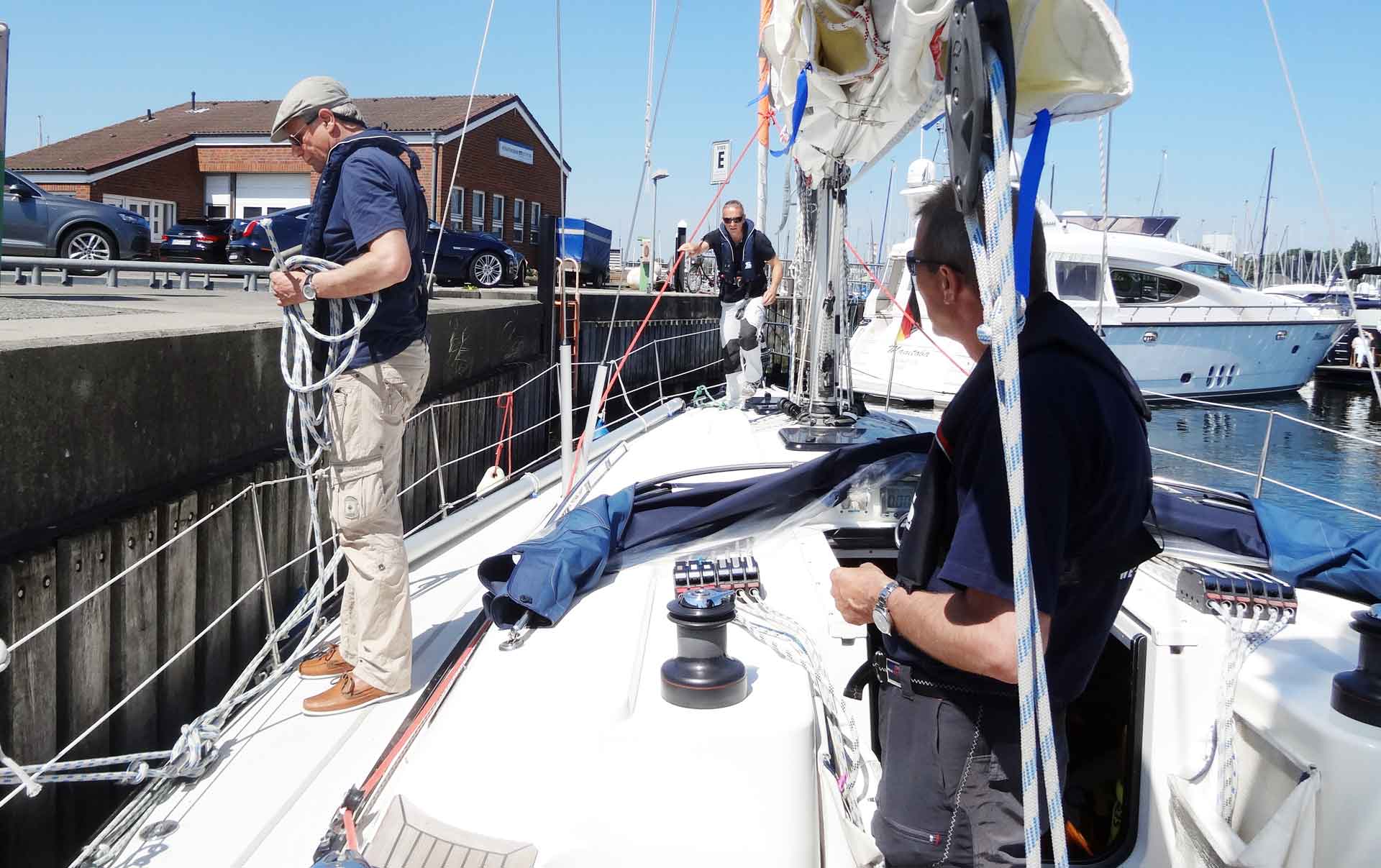
Again, our crewmate who “volunteered” to bring back our 13 meter yacht through the cramped harbor to her narrow berthing explained how he would land the ship. And again, Dietmar came up with an alternative suggestion. As experienced with my casting-off it wasn´t a by-the-book maneuver and I hardly got the details when he explained it, what I kept was something with “steaming stern ahead” and “landing with just one single rope”. Okay. That was new to us. So our boat went to reverse gear upon reaching the harbor entrance and, like steering a car, our acting helmsman placed himself “before” the wheel. Slowly he maneuvered our yacht alongside the various narrow turns. I was amazed how seemingly easy the ship responded – in reverse gear! We prepared the fenders. And one.
Single.
Rope.
“Prepare a stern rope on port side!”, Dietmar announced and so we did. One of us had to stand by to put the rope sling over the quayside bollard by means of a boathook. Slowly our stern neared the concrete quay in a 50 degrees angle. Controlled, by adding precisely timed forward pushes with the engine, our helmsman moderated our speed to near nill. “Put over the rope!” One final, strong push forward, stern headway reversed and the yacht inched into the rope. “Lay rudder hard port!”, and helmsman did. Slowly, in a graceful manor like being guided my magic forces, our yacht put herself nicely alongside the quay. With a hardly recognizable motion bumped her port side in the fenders.
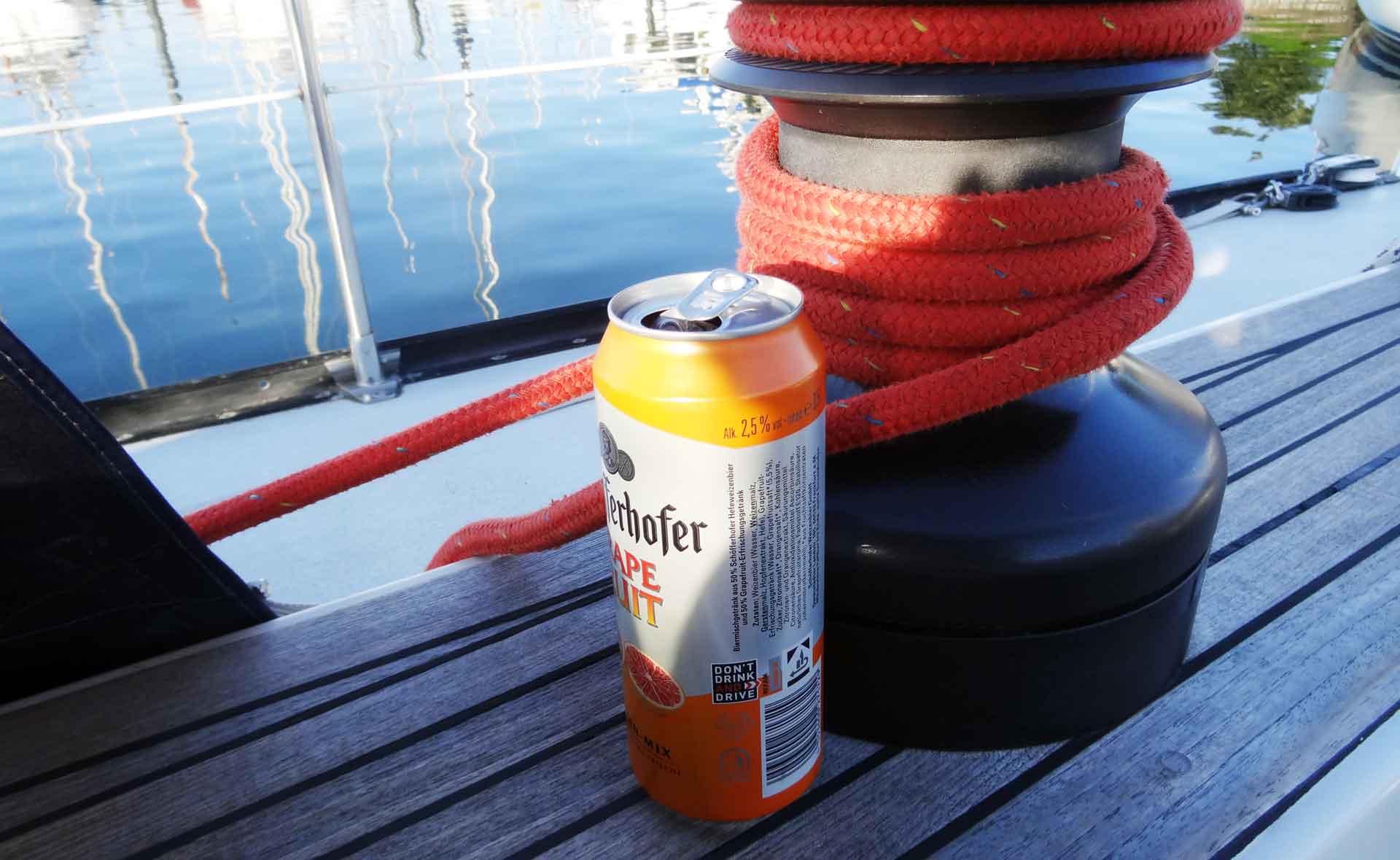
“Keep the engine forward, rudder hard portside. Steam her steady onto the quay.”, said Dietmar and we all stood by – puzzled by the ease and elegance of the whole maneuver. “You see”, Dietmar explained, “now our engine pushes the boat towards the quay, holding her stable without any more ropes. We have now all the time in the world to tie her up. Voila!” He put a grin on his face. We looked at each other, full of appreciation for this classy move.
The traditional “landing-beer” was ice cold and tasty. What a day! Full of joy and excitement, but also full of our own faults, errors and thus the realization of our own shortcomings. We discussed the day in a de-briefing. I put it short: “Today we learned … that we still have to learn a lot of stuff.” Dietmar agreed. And came up with some news about our exams: “The examination will due to organizational circumstances take place one day earlier than expected.”
Oh. Wow.
Light-Bulb Effects
We´ve been sitting and talking yesterday evening long, long hours into the night. It was an exciting feeling to be onboard the yacht – alone – as our skippers went home. Talking about ourselves, our “real” lives and our relationship to sailing we got to know each other better. Of course, we also talked about this class, our expectations, fears of the exam and questions remaining from the first day. As the sun went up again very early, I was the first to get up. Filling a cup with fresh hot coffee I took a seat in the big saloon of our X-Yacht and tried to suck in all I could: How the yacht moved gently tied up at the pier, how the air smelled (salty and fresh) and tried to memorize the sounds of the ship.
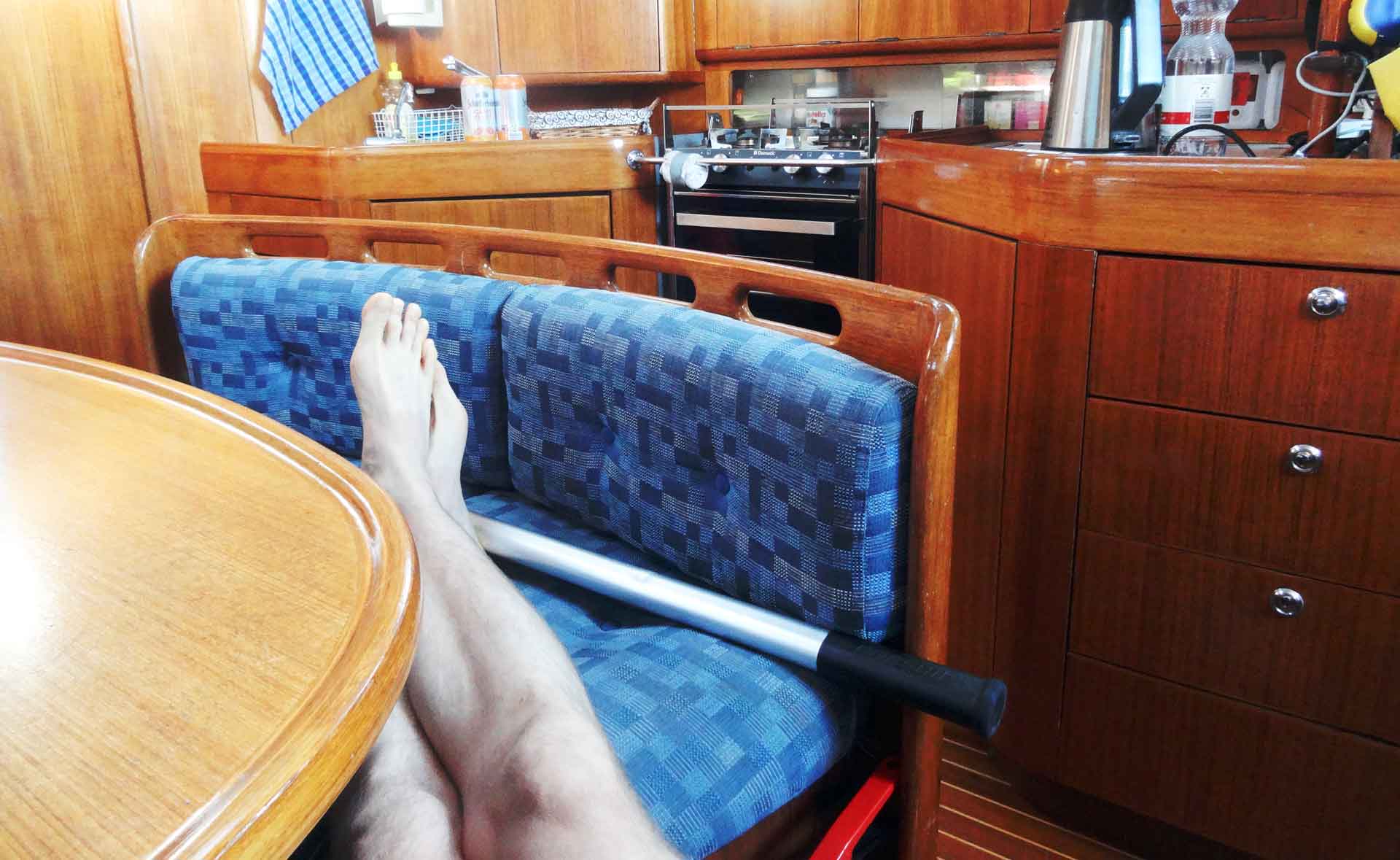
After my crew mates got up from their berths too we´ve had a nice and proper breakfast with a lively talk and at 9 o´clock began to clean the ship and make her ready for Day 2 of our course. Not that we have been emptied or uncharged with energy, but expectations were a bit uncertain as we still felt the passed first day deep in our bones: Yesterday we learned that we knew nothing. What will it be like today? One hour later our skipper arrived, not without us giving him a big laugh: As we were steaming into the harbor yesterday afternoon we´ve passed a big motorboat, a very expensive, huge coffer. Looking on her deck we noticed her ropes being arranged in rope-snails, which is a sign of extreme smugness. Skipper shook his head and went on. So, having some minutes upon his arrival left, we took our chance to “snail up” all of SY MERENNEITOs ropes and arrange them all over the huge cockpit, which caused him to chuckle hard as our old man arrived at pier side and – funnily enough – refused to board the ship until the snails be removed.
He would have his sweet revenge.
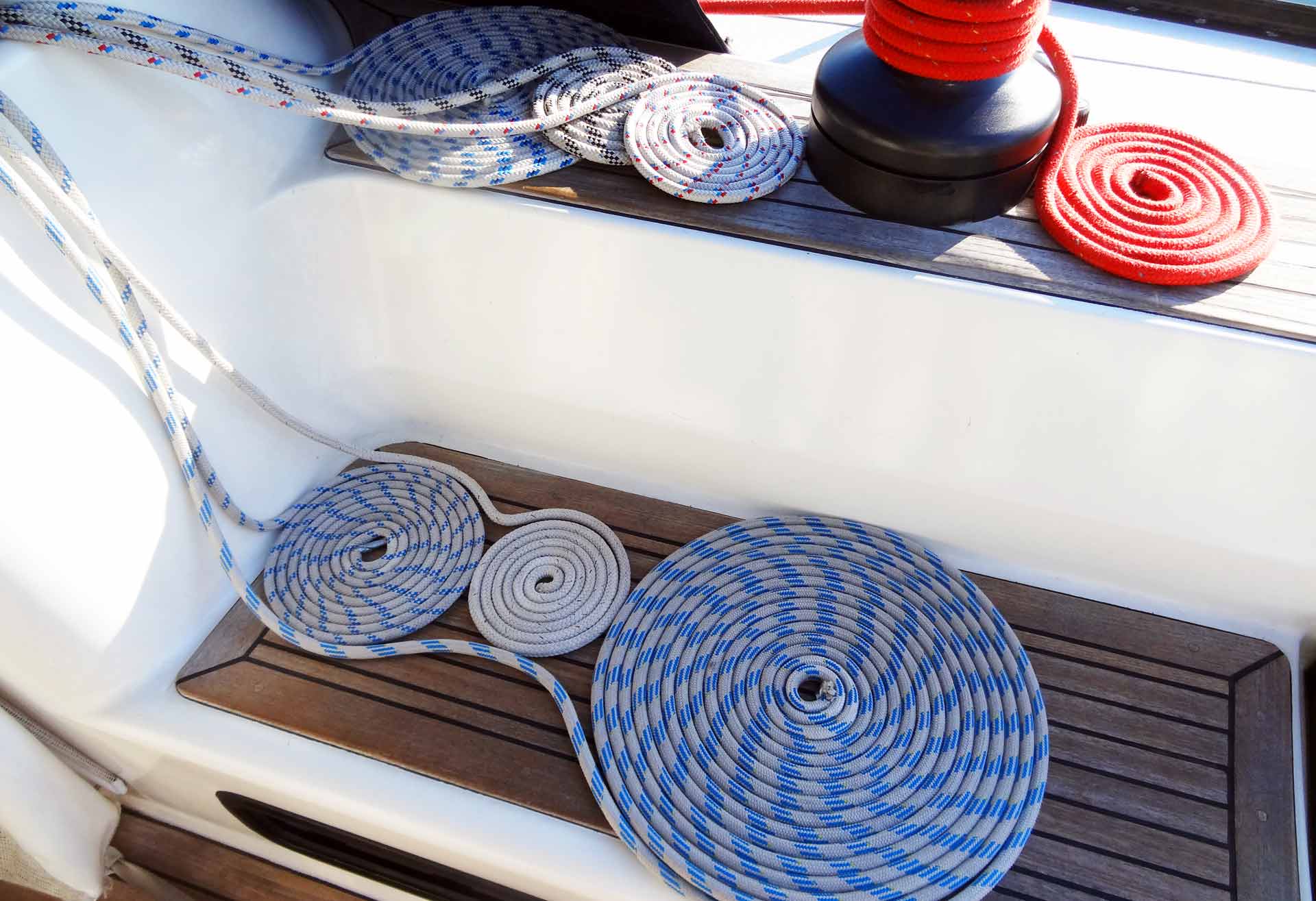
Day began smooth as we sat down in the cockpit not casting off immediately. Our skipper brought with him some fresh printed weather charts and we discussed high/low pressure, sense of rotation, winds and their force, clouds and precipitation patterns and all related stuff. Common sense, nothing really new, but basic groundwork for the exam. What I found particularly interesting was how to draw an isobaric weather chart by myself by just listening to the right radio frequency at the right time. One just had to write down the data of atmospheric pressure measures for some 25 European cities, temperature, high/low and direction of winds and transfer these data onto a chart: Voila. A general overview on the weather situation for North Sea and Baltic Sea with a window on the initial weather situation out on the Atlantic Ocean. Very interesting.
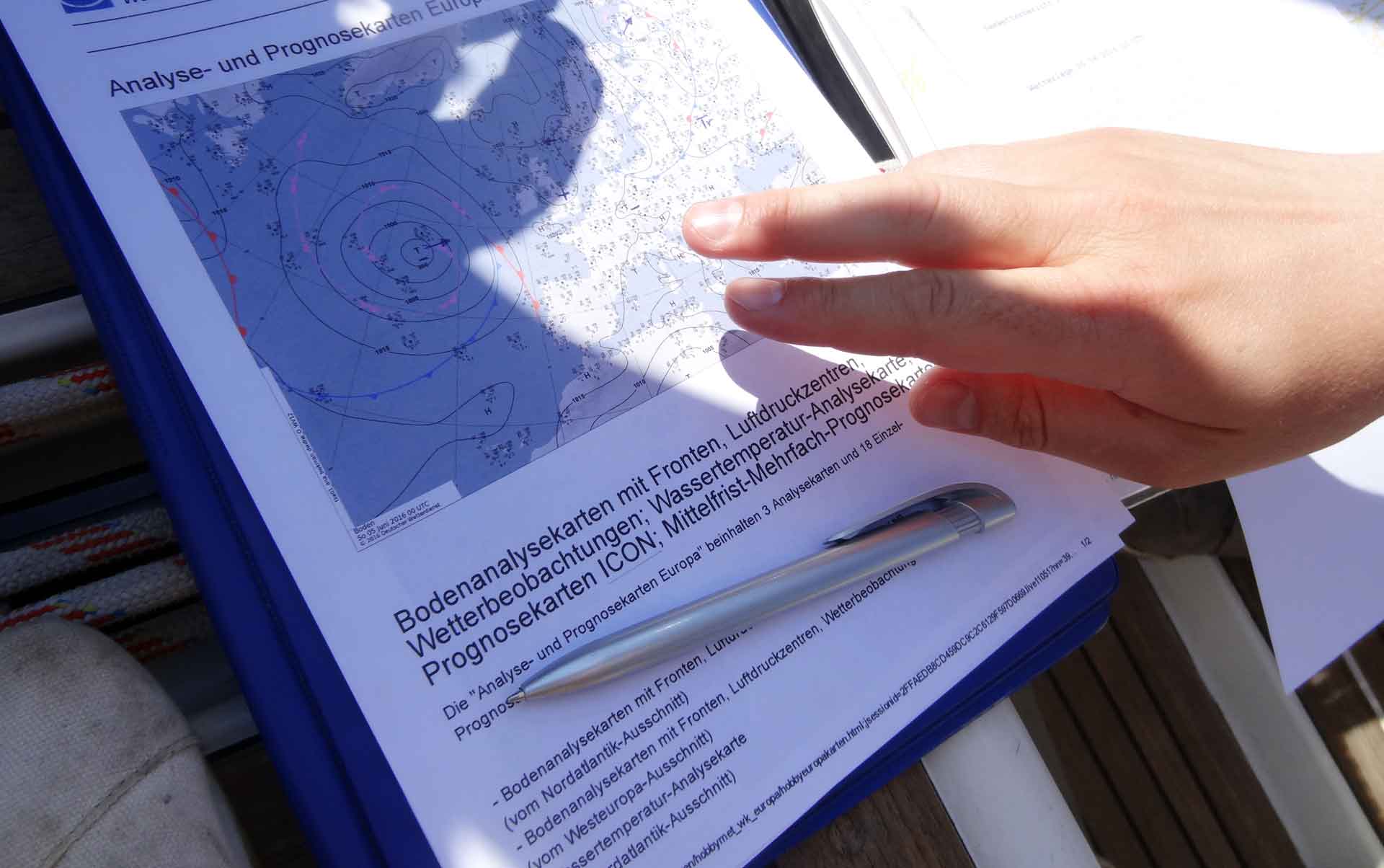
“All right boys, rig ship for casting off. Who´s going to do the maneuver?”, skipper Dietmar finally asked. As I was the one yesterday, another of our crew decided to do it. “Brief your crew.”, Dietmar advised, eager to hear how he would cast off in the first place. Lesson learned: “Have a stern rope prepared to seaward on the middle clamp.”, he replied, initially copying yesterday´s casting off. Dietmar nodding contended and we did our job.
Again, casting off by the means of steaming slowly away from pier side by utilizing the stern rope to seaward proofed a safe, smooth and stressless maneuver. By putting the ship with engine power against the quay first, we were able to take in all ropes without any hustle. What a nice maneuver. “Skipper, does this maneuver work equally nice both in shoreside and seaward winds?”, I asked. He grinned and confirmed:
“It always works.”
To our surprise we didn´t went out to the open sea in the first place and didn´t had our sails hoisted but took a sharp turn and followed the narrow fairway upriver to Neustadt town. “We will practice harbor maneuvering this forenoon”, skipper Dietmar announced and so we arrived at Neustadt harbor. Everyone was going to land and cast off some two or three times.

Again, by taking over helm, the relieved one had to hand over the ship by proper command language: Ship is steering this and that course, engine running in this and that level. “Get used to this command language as this is not just a point tested in the coming exam, but it will help you and others to run a ship properly later.”, Dietmar encouraged us. And: “Now land the boat at berthing position 23, port side.” One of us being in charge of the boat had to advise the crew to prepare fenders at port side, have a stern rope with boathook prepared, stop the boat´s forward motion and bring her stern ahead to a slow headway in a pointed angle towards the quay side. “When stopping the boat and bringing her to move stern ahead, you have to give full power to the engine for a short time because we need a certain momentum for her hull to have her rudder streamed in by water. Only by this we prevent a boat´s standstill and being committed to drifting.”, Dietmar gave small corrections to our actions.
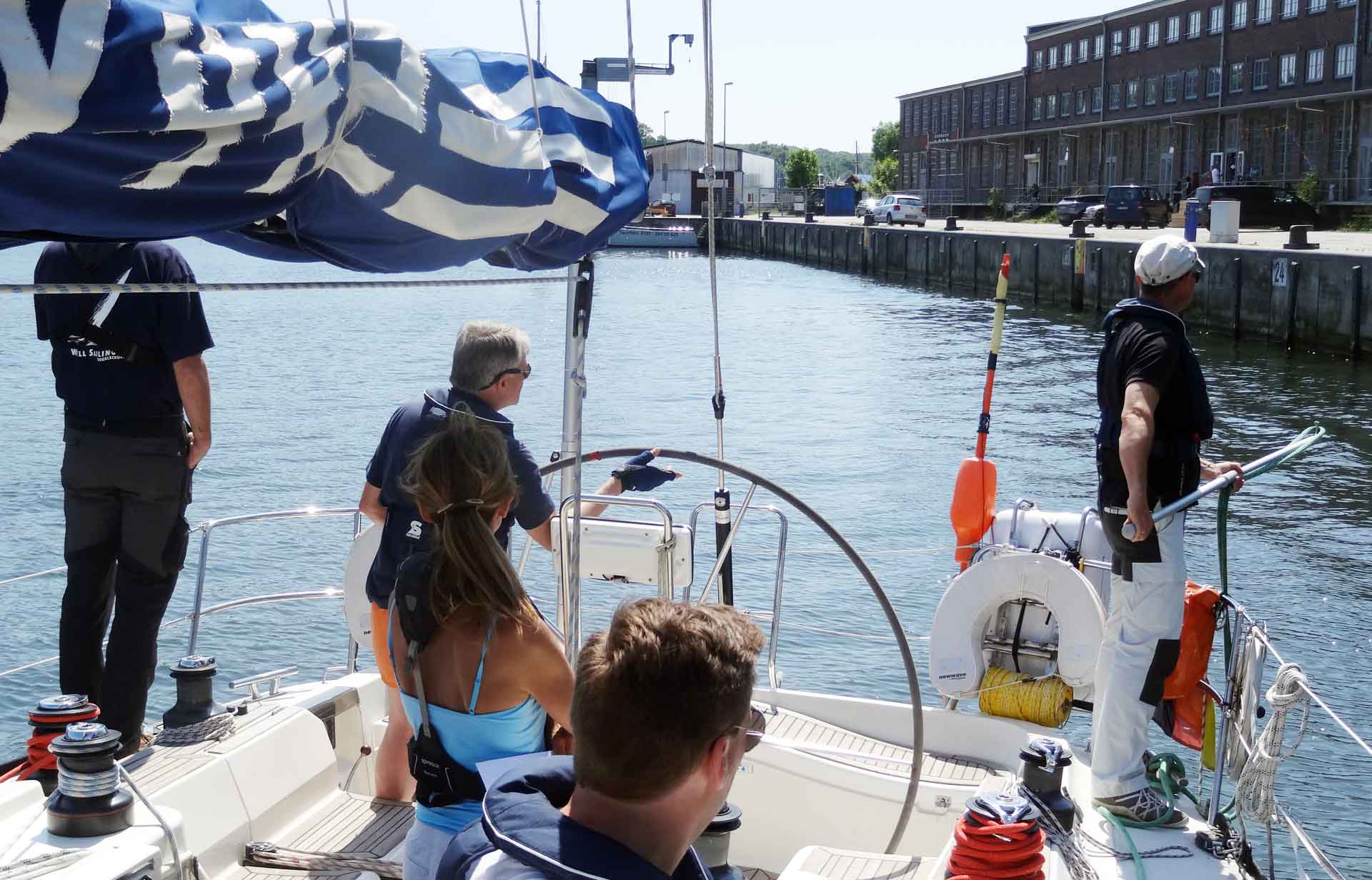
Again, heartbeats were fast for all of us as it is a strange feeling to be in charge of such a huge 44 feet sailing yacht. Besides, Neustadt harbor is a beautiful picturesque place full of tourists. Staring tourists: Nobody of us wanted to make a fool of oneself by crashing the stern into the concrete quay. Slowly but certainly our ship was steaming with her stern towards the pier side, right onto the mark “23”. I was astonished how precise the ship was able to follow even slightest steering commands by the wheel even by making not a single knot. All the man on the helm had to do in the first place was to aim her port side stern fender at the designated point of landing and bring her near the bollard.
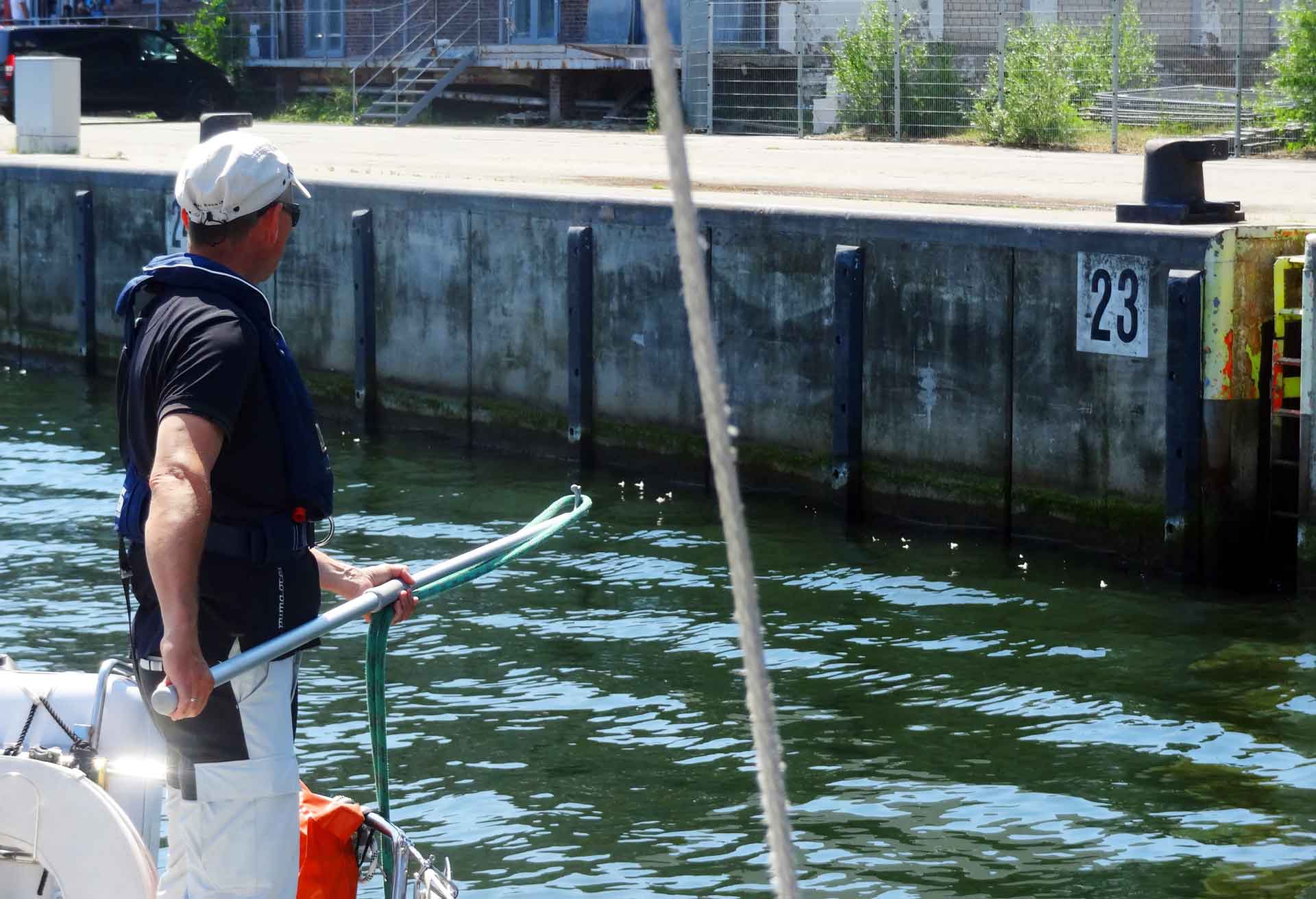
When distance to the quay was down to 5 or so meters engine was set into neutral. Again, slight steering corrections applied, boathooker braced for putting over the rope. When distance was further reduced to 2 or 3 meters engine was set to run forward in the smallest gear, beginning to slow down the boat slightly. Now good timing was needed: Just 20 or 30 centimeters from the quay, right at the very moment when the rope was put over the bollard, engine was set to full ahead – just a blow to the screw – and set to neutral again. The ship jumped forward a bit, tightening the rope.
“Now slow ahead, bring her alongside quay”, Dietmar advised. Again, gracefully as ever, our X-442 pored over nicely and brought herself in line with the pier side. That would be it. Time to steam her into the quay to stabilize her by full port side rudder and again, it would be possible to tie her up in a smooth manner. “Nice maneuver”, Dietmar praised our helmsman: “Change helm, cast off and … let´s bring her alongside berthing number 11.” Another one was to cast off – the Dietmar-way by utilizing seaward stern ropes on the middle clamp – and land her at the designated position.
It was exciting.
And so much fun.
With each and every maneuver – with wind from all possible directions – we learned so much about the ship´s behavior under various conditions and got to know her more intimately and above all: That casting off by means of seaward ropes and landing stern ahead was the ultimate stressless maneuver. Above all: A maneuver which can be performed single handed with ease.
“Let´s have lunch.”, Dietmar announced after some 4 hours of harbor training: “And then go sailing!”

Filled with fresh fish from one of the pier side restaurants we were casting off an hour later and went back to open sea, hoisted sails and put the ship to a close hauled course. Dietmar used the first half an hour to drill the crew for fast tacking-maneuvers and – I noticed this with quite an excitement – we acted much better as a team than yesterday. It seemed that everyone of us anticipated the next moves needed on the station, also thought for his crew mate and worked his winch with better reliability.
“Get ready for a gybe!”, our skipper announced surprisingly. “Ready!”, we shouted.
A gybe!
“Pull in mainsail!”, Dietmar gave the first command and so I worked the winch to get our main close.
“Gybe ho!”, another command as our helmsman lay rudder – smoothly – and brought our yacht´s stern through the wind. As our fore fell Dietmar announced “Gybing!” and shortly after: “Take over fore, veer main!” and we complied, opening sails to the new wind direction and completing the maneuver. “That´s it, nothing more. No reason to fear or condemn the gybe. Just proper command language and tidy works on the winches.” Well. Let´s see. We changed helmsman and positions at the winches again, another gybe, this time without Dietmar´s help.
It went … okay. Sometimes rudder was too hard, speeding up the maneuver unnecessarily thus adding stress to the winch-workers, sometimes one would instinctively steer for a tack instead for the gybe and sometimes – the standard fault when gybing – mainsail was veered too late putting too much wind into the sail to let the boom bang into the shrouds.
Ouch!
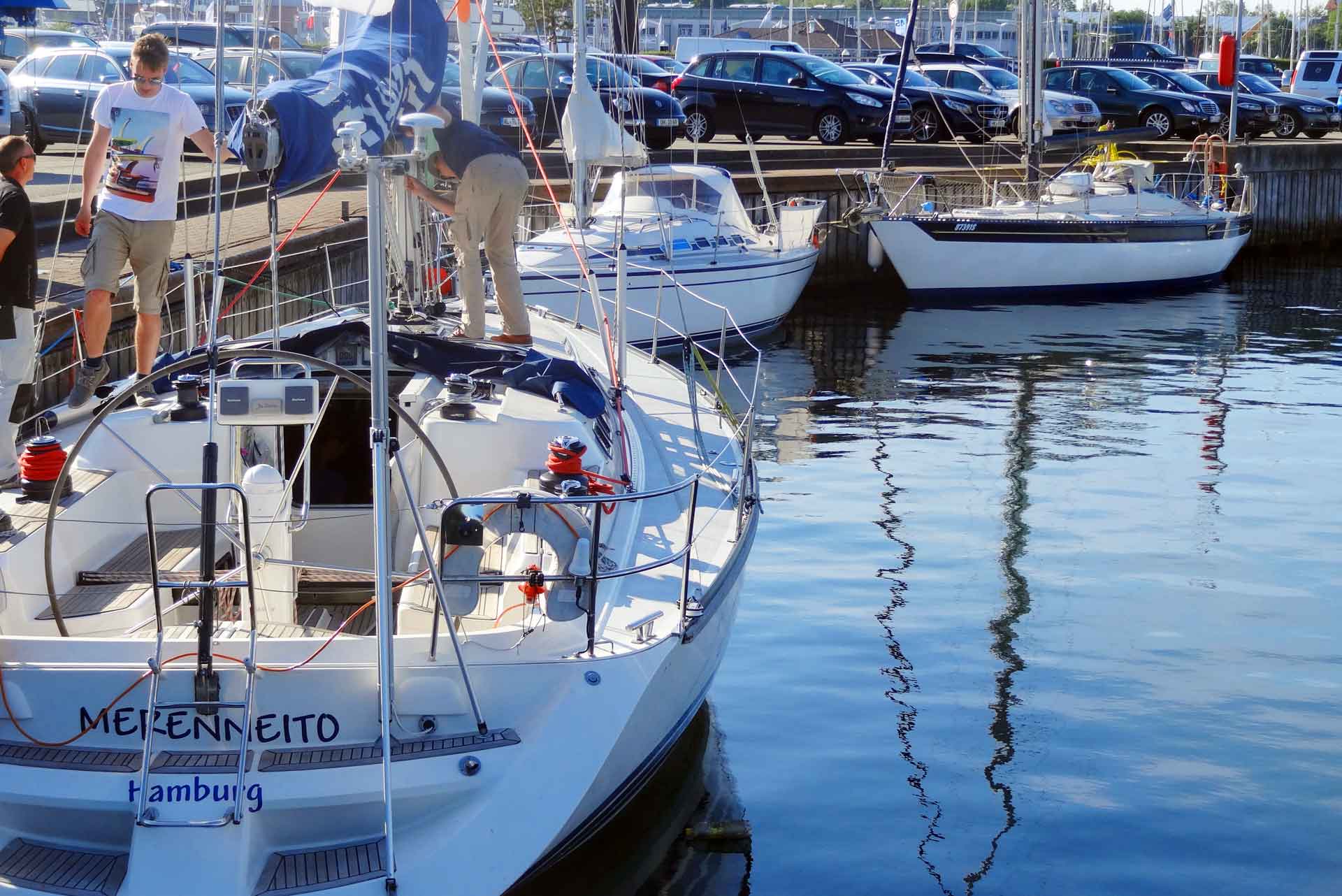
Another 3 hours later we´ve had SY MERENNEITO tied up at pier side of our home base again, exhausted but excited. Sitting together and having our de-briefing everyone talked about his feelings and what he did learn today. All together we praised the harbor-maneuvers which provided for the first real light bulb effects: “I didn´t knew that landing a big ship like this could be done in such a stressless, seemingly effortless, neat and clean manner”, I said. “It´s really as easy as ABC!”, one of us added. Dietmar nodded: “Steaming stern ahead is also a safety precaution: If you should suddenly realize that something goes wrong, berths are occupied, another boat coming up dangerously or name it – just flank ahead and steam away bow ahead. That´s safer because if done the other way round – trying to land bow ahead and having evade stern ahead, that´s far more complicated.”
Again, we learned, that this yachtmaster class is not just about passing an exam. It is meant to accumulate knowledge in handling a ship properly and teach seamanship over all.
“Have a nice evening folks”, Dietmar and Andrea said upon leaving for knocking-off time. See you tomorrow, we answered and braced for dinner.
What a great day, full of so much learnings!
“Examination should go right”, I anticipated, noticing a King´s Cruiser 33 at pier side just next to our ship as a good omen.
The Day of Mistakes
Next morning, day 3. As our beloved Sun dawns I am the first out of the bunk again, the first in the marina´s showers and the first to enjoy a hot freshly brewed coffee sitting in the cockpit, taking the warm sunrays as a treat. A lot thought went into yesterday´s performance and what might be on schedule for today, but in the end I laid back and welcomed my crew mates who one after one got up too. As ever, we´ve had a nice crafty breakfast with scrambled eggs, bacon, croissants and honey and looked forward to the things to come.
As Dietmar, the skipper, and Andrea arrived, it was chart work we began with.
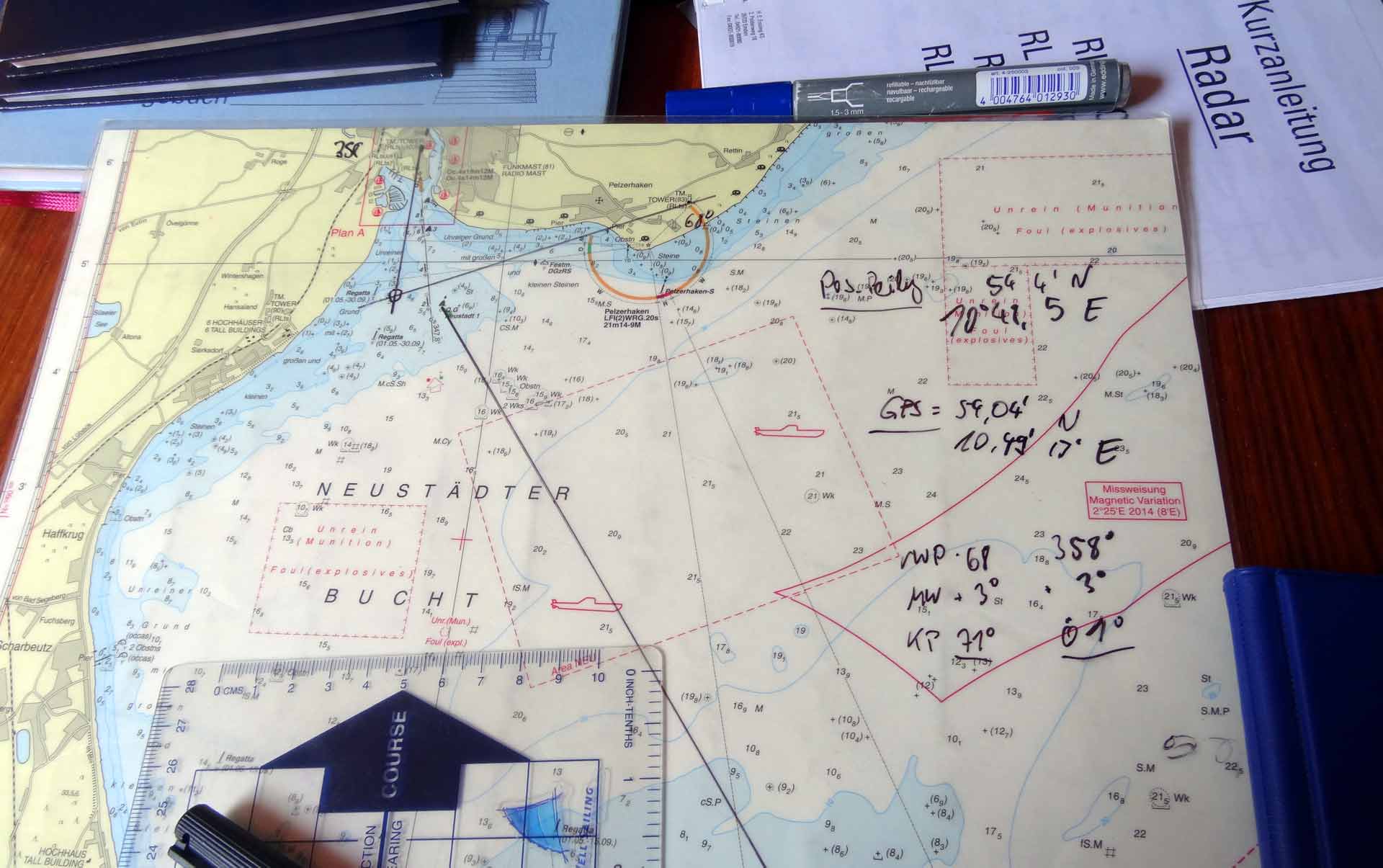
“Part of the examination can be taking a cross bearing and determine the boat´s position”, Dietmar explained and we all nodded. Measuring bearing by means of a compass, computing total errors and having marked true bearings into the chart to determine one´s position was a no-brainer for us all. And because of that, we were able to quickly close that chapter, take on our sailing clothing and get ready to cast off again.
Wind had freshened perceptibly from 3-4 bft yesterday to a stiff 4 with occasional gusts of up to 5 bft and so we set our main sail in the third reef. “What a blow!”, I shouted in excitement – 8.6 knots through the water, 7.6 knots over ground: “With three reefed main and storm jib! What a fantastic yacht!”
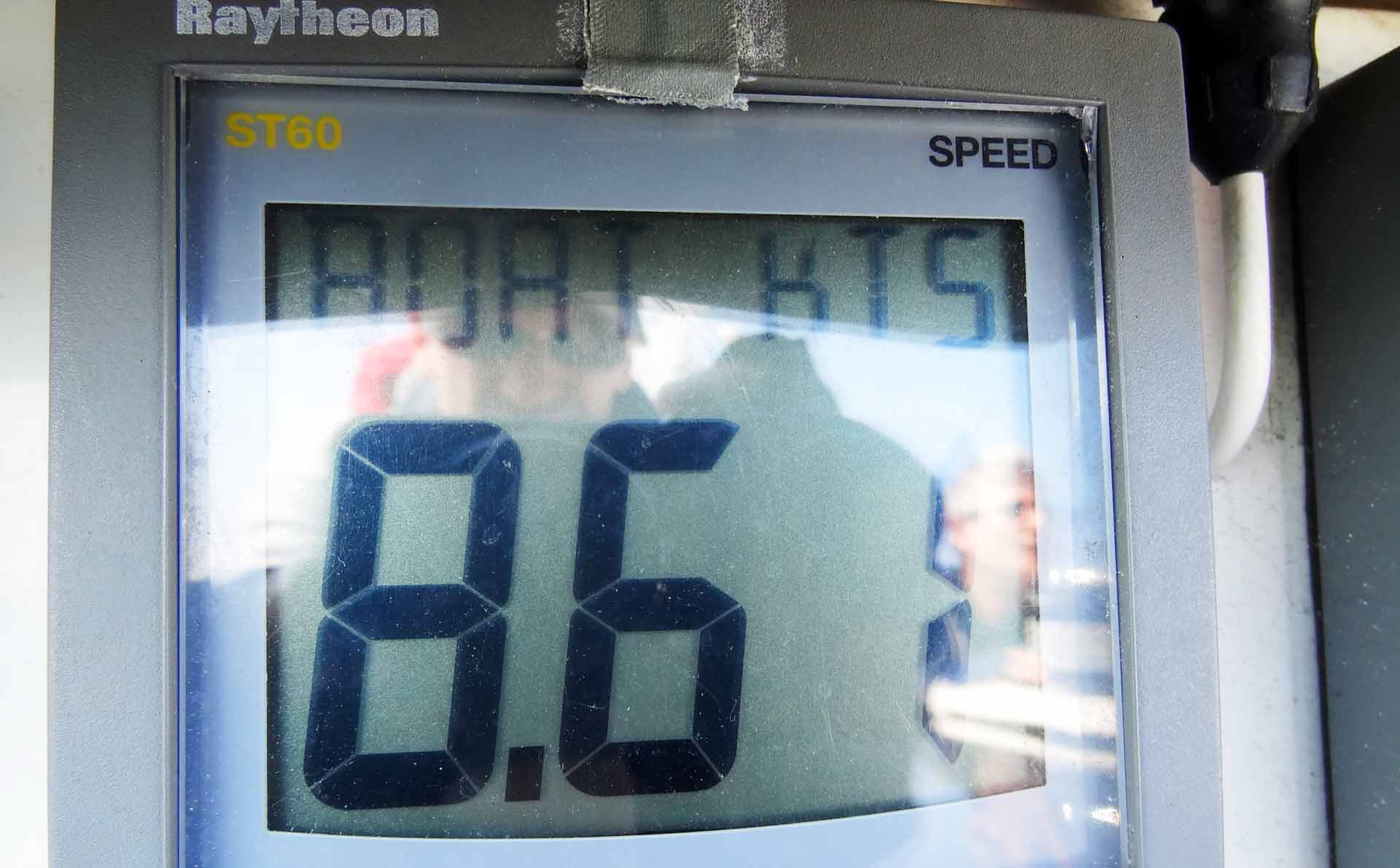
As we´ve reached our training area Andrea prepared the MOB buoy. Dietmar asked: “Anyone in for performing our first MOB?” Again, as everyone else hesitated, I volunteered. Thinking back to my basic sailing class some weeks ago, it was the Figure-8 maneuver for MOB I did have the most fun performing, so I thought, what could be different from doing so in a 44 feet yacht?
“Luff to close hauled course.”, Dietmar advised. A second later: “Man over board on starboard!”
The rest came out of my mouth and hands in an automatic manor:
“Man over board!”
“Man lookout post!
“Push M.O.B.-button, drop lifesaving equipment!”
“Veering to broad reach for a Figure-8!”
My crew responded as I had already altered course and opened the sails by veering the sheets. From behind, Dietmar – acting as lookout – counted the distance in ship-lengths.
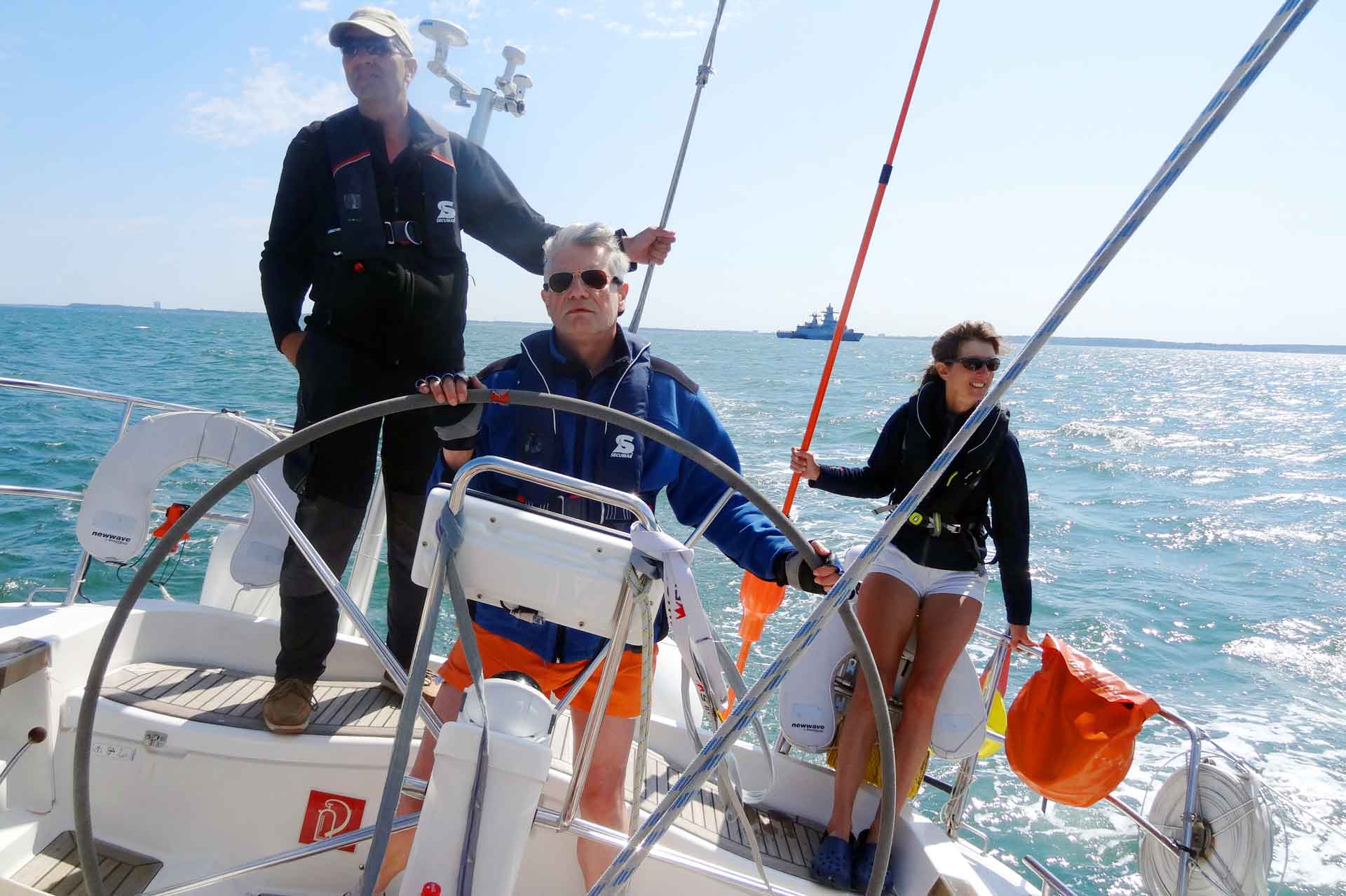
“Four – five ship lengths!” I quickly took a look behind myself, and again: “Ready for tacking!” and turned the wheel als SY MERENNEITO flew plowing through the waves and quickly got her bow in the wind, turning longer bringing her to port tack. “Ready to let lose all sheets upon my command!”, I announced and my mates took off some turns from the winches. I watched the buoy floating in 3 ship lengths abeam, took a look onto the speedometer, 3.8 knots. “Let lose all sheets – prepare to take on the buoy on starboard side!”
As I gained enough distance, I turned the wheel bringing her into the wind, hoping to have a near to complete standstill next to the buoy. Which was impossible, but Dietmar grabbed the thing with ease. As we were on course again he analyzed my maneuver and gave a – slight – compliment: “Execution of the Figure-8 was okay, still, the boat a bit too fast.”, he said and added: “But don´t worry, this is an X-Yacht. And she is made to run!” We changed wheels.
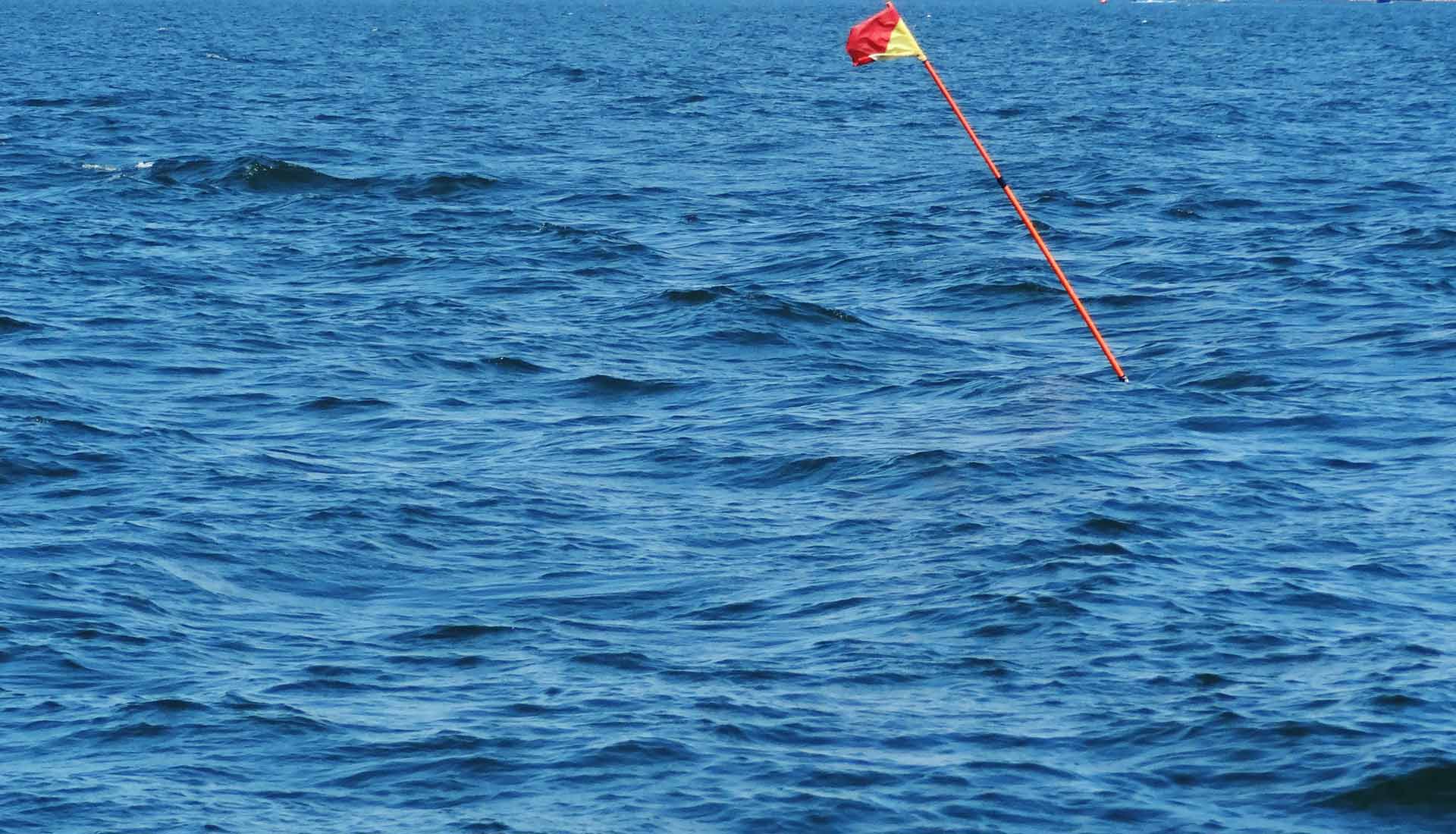
Everyone was now performing at least one MOB by doing the Figure-8 and we slowly got a feeling for the boat, although, stopping her completely has never been managed by anyone of us – even though we´ve had stiff winds blowing and waves of up to 0.80 centimeters. More and more acting as helmsman or on the sheets became routine – and with it we began to lose concentration. Sometimes one would forget to take over the jib after tacking, sometimes an unintended gybe was produced (“This leads to an immediate cancellation of the examination!”, Dietmar warned) or one would simply tack around the buoy instead of directly heading for it. Classic: Complete devastation of the whole maneuver by having the final approach to the MOB buoy with the wind instead of against it.

Hours went by and weather worsened. It was exhausting to work the sheets, especially at the main winch because sometimes Dietmar would let us perform a gybe to add a “little spice” to the training, which is always a load of power requiring to get the main close and veer it away quickly enough. Again, it has been the gybes which caused most trouble among the crew for some of my crew mates found it hard to instinctively act. And acting fast is something an MOB maneuver requires. Especially hard was having an MOB directly in the midst of another maneuver, causing havoc in the cockpit.
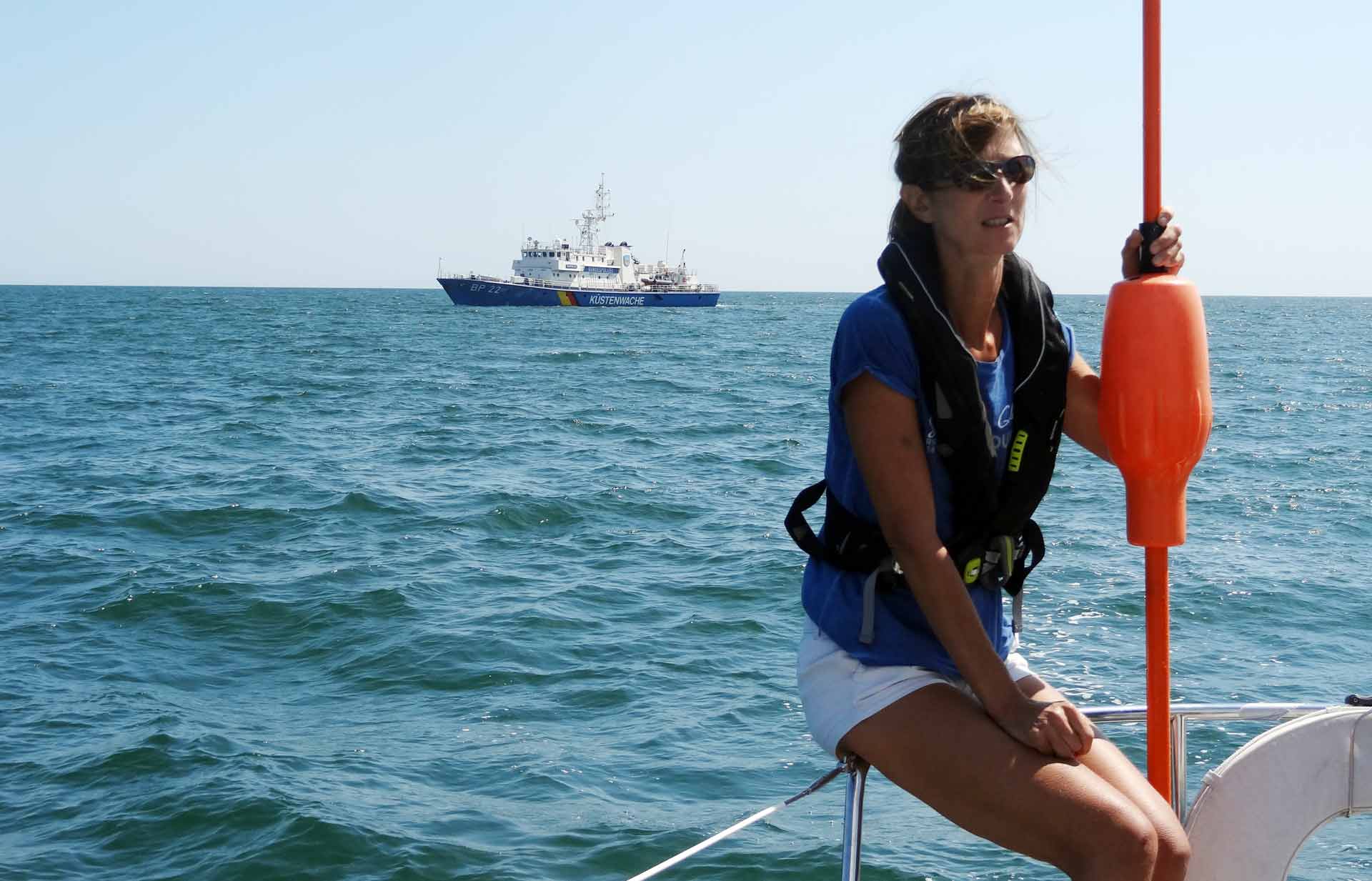
We drew the attention of both the German Navy and the Coast Guard, both had a Frigate and an SAR-ship nearby closing in on us and probably watching us circling around the red buoy. Dietmar stayed cool: “They do know this boat, no problem.” His tactics were crystal clear: By chatting around a bit and ordering this and that maneuver he hoped to lull the crew, just to give Andrea a secret nod for pushing the buoy overboard and turning routine into hustle. Again booms smashed into the shrouds, gybes instead of tacks and on some occasions we simply ran over the buoy.
Tiring drill. “Tack!” “Gybe!” and “Man over board!” countless times. I figure, we must each have rescued the damn boy a dozen times today.
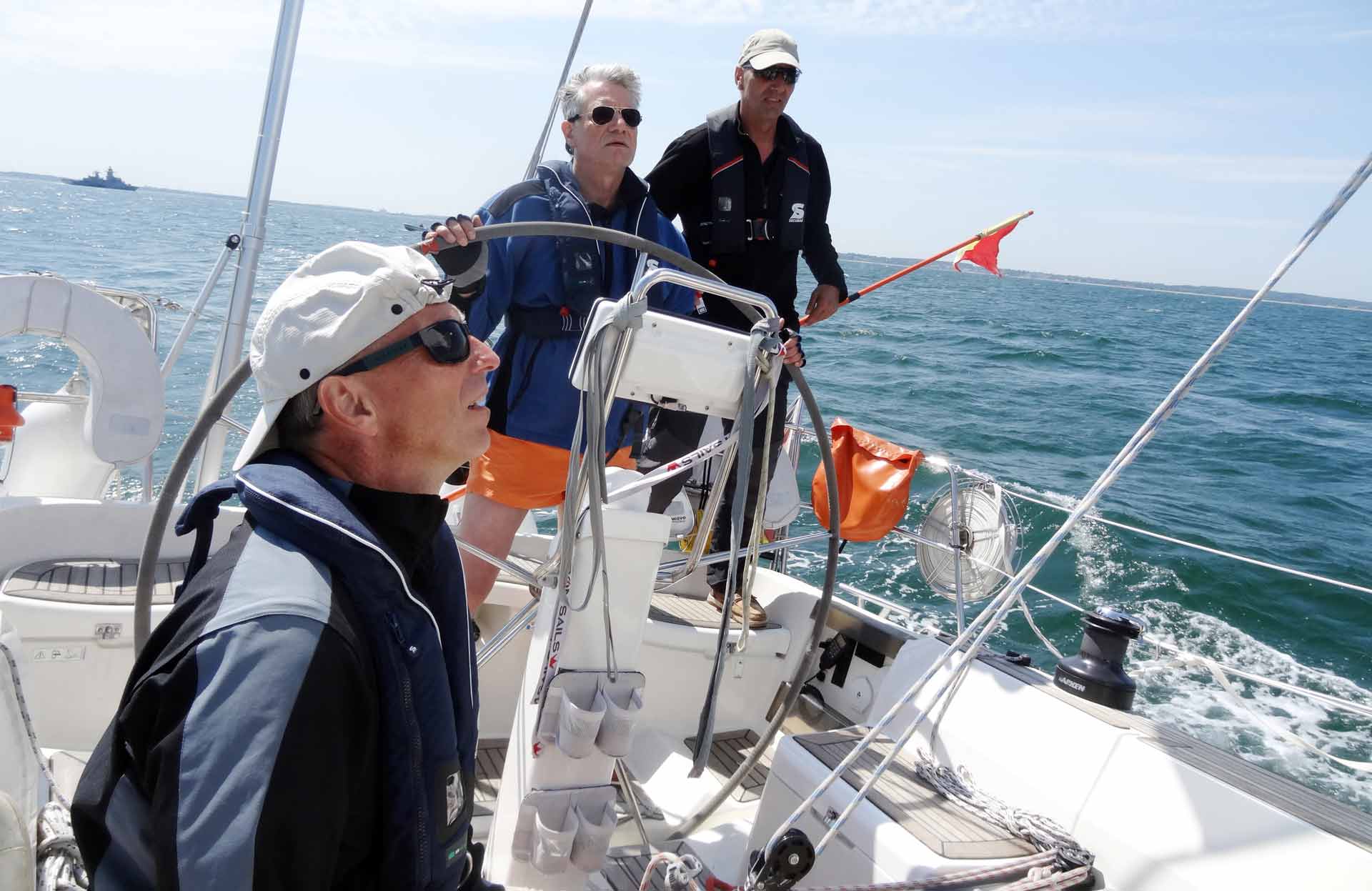
Water began to splash onto the freeboard as the hull plowed the waves, we´ve had noticeably more swell going on the ship´s motion became more violent. One of our crew announced a slight seasickness, relieving himself below deck (which I wouldn´t have done in the first place) and so we´d had to work with one less. Which added some fun to the game. Again, SY MERENNEITO jumped up and down and salty spindrift hit our faces. Finally, my muscles began to ache, wind pressure increased further and as we sighted thick black clouds on the horizon, the harbinger of a lightning storm, Dietmar decided to return to harbor.

Steaming back to Neustadt bay we took down the sails – pretty much fun in such a gusty wind – and took our seats to rest from the exhausting drill session this day. We cleared all ropes and sheets, put the tarpaulin back over the main sail and finally took off our gloves. Longing for a good dinner, we all sat down in a mood of being – let´s say – a bit cracked. “So much mistakes today”, as somebody of our crew did sum up the day, and I would add: “Today was a day of mistakes. A lot of. We need more attention, more anticipation and more concentration.” Dietmar agreed, but build up our confidence as well: “You will get better as you now have seen that sailing is a sometimes quite a serious matter. You will get safer in executing the maneuvers, instinctively making the right decisions.” He was so sure about that …
Can we make it? Passing the Exam?
As the two had left the boat we remained onboard, cleaned up the cabin and talked a lot about tacks, about gybing and points of sail. We discussed maneuvers and how we should behave during exam: “It would be a disaster if one of us fails because of somebody at the winches not behaving according to the commands”, I said. Sometimes the jib would be taken over without the helmsman having announced to do so – which is a thing we must not do during exam: “What if I wanted to have the jib standing aloof to speed up a tack, but you take it over without order thus messing up my maneuver?” That was my point.
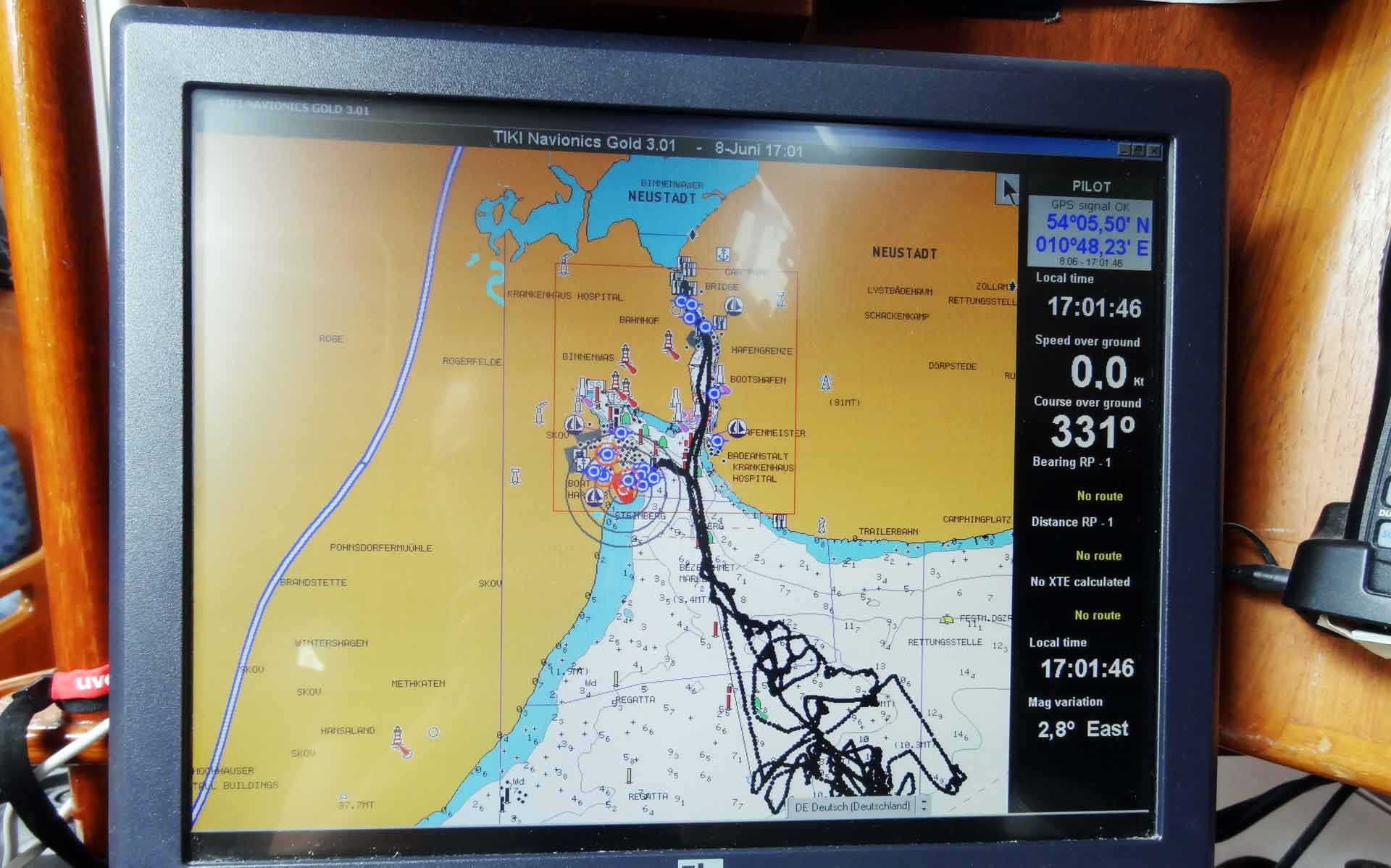
On the other hand, as somebody answered: “What if you fail the exam because you simply forget to have announced taking the jib over and it remains aloof – as we have seen today on so many occasions?” That´s a point too. By having a look onto the GPS track on our ship´s plotter I could contemplate today`s work: So many gybes, tacks and MOBs, so much work we went through and so many meters of ropes I had veered through my own hands.
“Let´s have dinner, folks!”, I suggested and after a quick dash to the nearby supermarket some 2 kilograms of minced meat, tomatoes and spaghetti boiled in the pans of our nicely neat galley.

Even whilst dinner our thoughts circled around maneuver sailing. Pressure was high and we had all te same feeling of “let´s be better tomorrow!” and show our skipper that we are an able crew. Beer went down our throats and so discussions got more intense, as we left the saloon into the cockpit again and had roleplay mocking maneuvers, talking MOBs time and again and searching for techniques and rules to be able to work together better tomorrow. “I want to pass that damn exam!”, we all agreed, although the SKS is not a ministerial legal binding certification, it´s just a sign of capability and good seamanship.
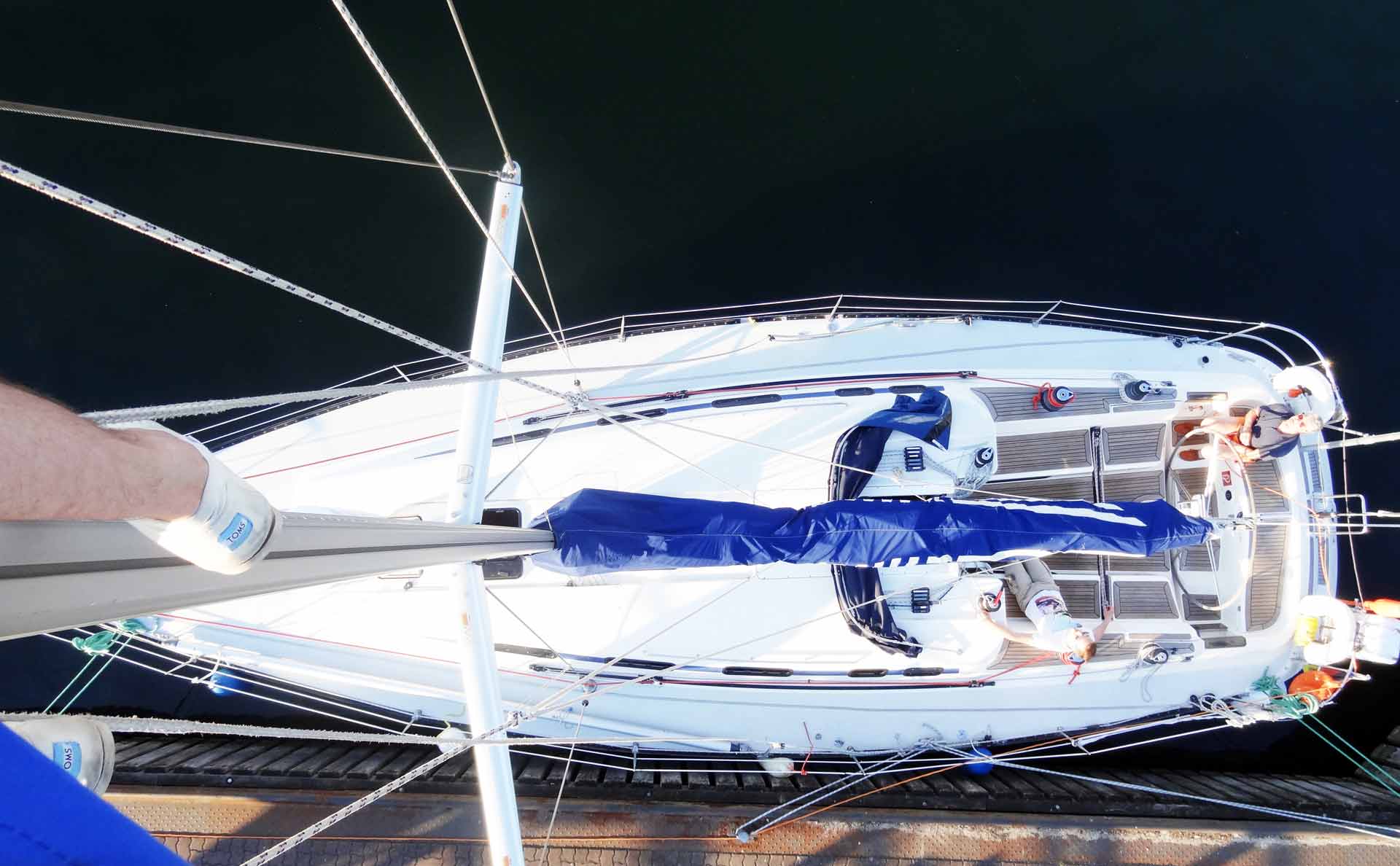
So, as the sun began to finally set, I made come true a long curbed dream and had me wound up to the top of our X-Yacht´s mast. Well, to be honest, it has only been up to the middle, some 10 meters, as our boat was rolling a bit and I found it some kind of disturbing hanging onto a rope that was just furled three times over a winch. Nevertheless: The view was worth it.
We went to bed earlier than yesterday. It has been a lot quieter onboard as well as we had a couple of beer. Today, at the end of our third day, we were just completely exhausted.
Will we make the exam?
Stay tuned for Part 2 of this series: Sailing the hot way and getting ready for examination day. Will we all make it to pass RYA Coastal Skipper / SKS certification? Read it here.
